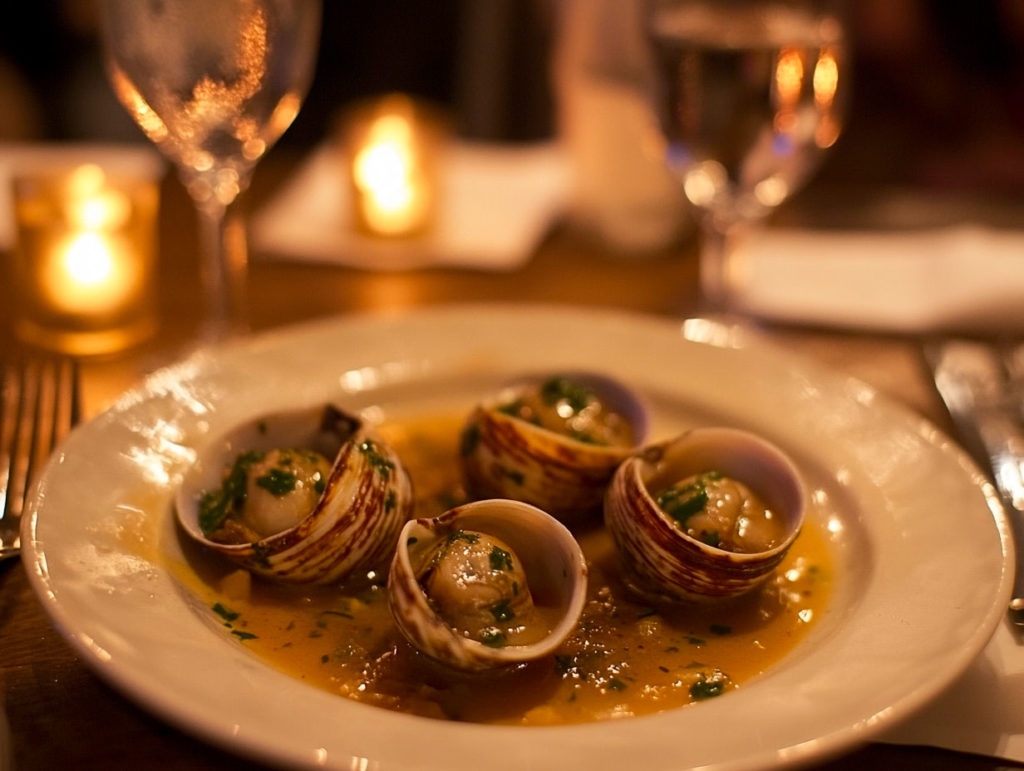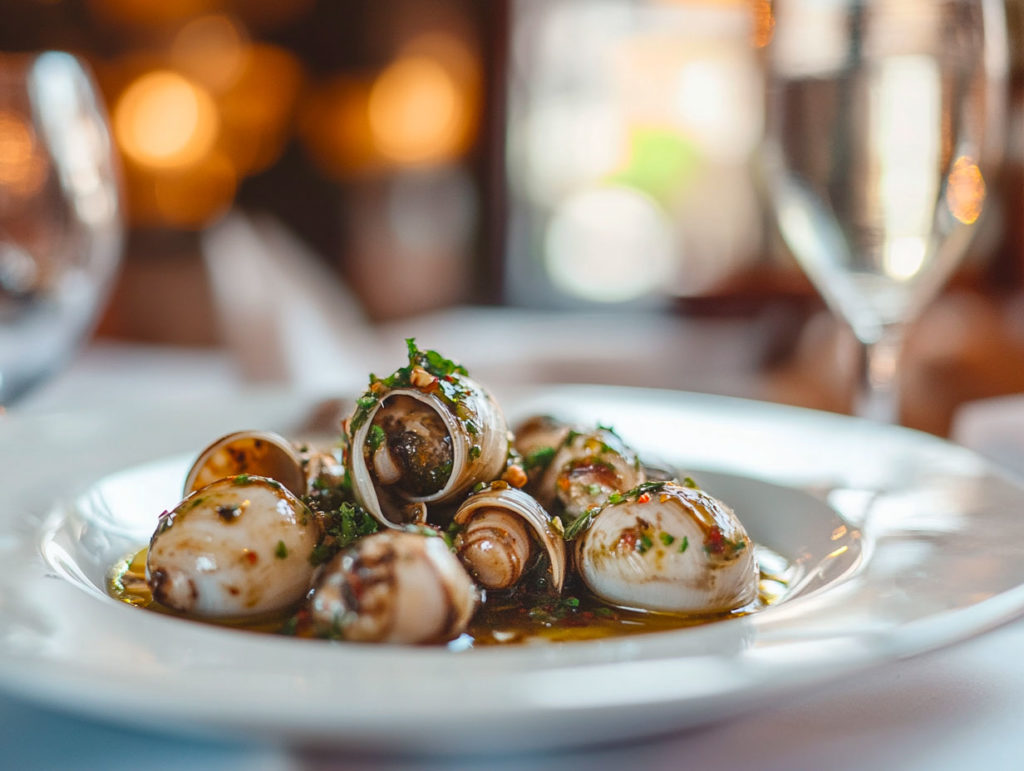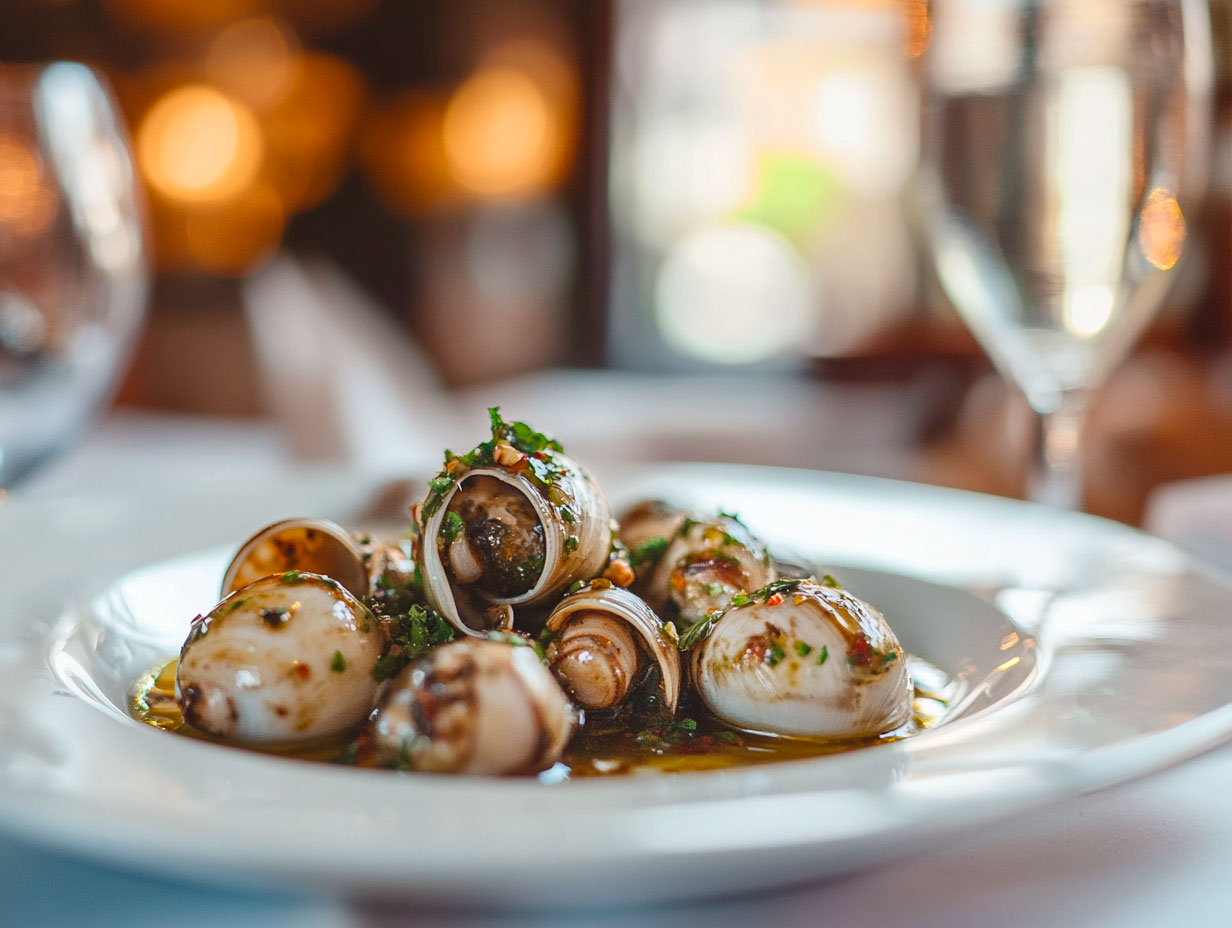Learn how to cook escargots de Bourgogne with garlic and parsley butter. A classic of French cuisine, step by step, with precise techniques and tips.
A traditional dish from Burgundy
Escargots de Bourgogne are a regional preparation from eastern France, known for their garlic and parsley butter. Traditionally made with Helix pomatia snails, this dish is served hot in ceramic or metal plates with indentations. It is consumed mainly during festive meals, especially around Christmas in France. Burgundy, and particularly the departments of Côte-d’Or and Yonne, are closely linked to this specialty.
The dish is considered part of traditional French cuisine and appears on menus in brasseries and fine restaurants alike. Preparing it at home requires specific ingredients and precise preparation, including sourcing the right snails and preparing the stuffing.

Ingredients and sourcing snails
Choosing the snails
The classic Helix pomatia, also called gros blanc in France, is protected and cannot be commercially farmed in France. These snails are mainly collected in the wild, following strict regulations. However, most escargots sold today come from Eastern Europe, especially Poland, Lithuania, or Romania.
Fresh live Helix pomatia snails are rare in retail. You can find frozen or canned snails at French delicatessens or online for around 10 € to 15 € per dozen (about £8.60–£13 / $11–$16).
Ingredients for 4 servings (24 snails)
- 24 Helix pomatia snails (frozen or canned)
- 24 clean snail shells (often sold separately)
- 150 g of unsalted butter (5.3 oz)
- 3 garlic cloves
- 1 small shallot
- 1 bunch of fresh parsley (about 20 g / 0.7 oz)
- Salt (5 g) and freshly ground black pepper
- A dash of dry white wine (optional)
Shells can be reused if cleaned thoroughly. New shells cost about 5 € per dozen (about £4.30 / $5.50).
Preparing the snails
Cooking and cleaning
If using frozen snails, they are pre-cooked and ready for stuffing. If using canned snails, drain and rinse them in cold water to remove the brine.
In traditional preparation with live snails, they must be purged (kept on fasting for 3–5 days), washed, boiled with herbs, and then removed from their shells. This process is time-consuming and is rarely done outside professional kitchens.
Making the garlic and parsley butter
Chop the parsley, garlic, and shallot finely. Combine with softened butter and a pinch of salt and pepper. Mix thoroughly until the ingredients are evenly incorporated.
Some variations include white wine or breadcrumbs, but the classic recipe remains simple.
You can prepare the butter ahead of time. It can be kept in the refrigerator for 48 hours or frozen for later use.
Stuffing and baking
Assembling the escargots
Place a small amount of butter at the bottom of the clean shell. Insert a snail, then fill the shell to the top with butter, sealing the opening. Use your fingers or a piping bag for better control.
Make sure the butter is compact to prevent it from leaking during cooking. Place the filled shells in an escargot plate or on a bed of coarse salt in a baking dish to keep them upright.
Cooking process
Preheat the oven to 180°C (356°F). Bake for 12 to 15 minutes, until the butter is bubbling. Do not overcook, or the snails will become tough.
The dish must be served hot, directly from the oven. The butter must stay melted, and the shells warm.
Serving escargots de Bourgogne
Utensils and side dishes
Escargots are served with special tongs to hold the shells and small forks to extract the meat. These tools are standard in French tableware shops. A set of escargot tongs and forks costs around 8 € to 12 € (about £6.90–£10.40 / $8.80–$13.20).
The dish is often served with baguette slices to soak up the butter. Some people pair it with a white Burgundy wine like a Mâcon or a Chablis. A good bottle costs around 10 € to 18 € (about £8.60–£15.50 / $11–$20).
Texture and flavour
The texture is slightly chewy, but not rubbery when properly cooked. The butter gives most of the flavour, with garlic and parsley dominating. The snail itself has a mild, earthy taste.
Nutritional value and consumption trends
Escargots contain 16 g of protein per 100 g, with very little fat (about 1.4 g). They are a low-calorie, high-protein food, though the butter adds significant fat and salt. One serving of six snails with butter contains around 250 to 300 kcal.
While not widely eaten outside special occasions, escargots remain a symbol of French cuisine. According to the French Interprofession des Escargots, over 16,000 tonnes of snails are consumed annually in France, especially in December.
However, consumption has declined slightly over the last two decades. Reasons include changing eating habits, shorter cooking times expected by consumers, and difficulty in sourcing good quality snails.
Preparing escargots outside France
Cooking escargots in France is facilitated by easy access to quality ingredients. Outside France, snail products are less common in supermarkets but available online or in specialist food stores.
Shipping canned or frozen snails and butter mix ingredients is feasible. However, local regulations may limit imports of live Helix pomatia due to environmental protection rules.
In the UK and US, you can find farmed Helix aspersa or Cornu aspersum, which are smaller and milder. They require shorter cooking times, around 7 to 10 minutes, to preserve texture.

Final thoughts: positive, neutral and limiting aspects
Escargots de Bourgogne require time and precision, especially for stuffing and cooking. The dish is relatively easy once ingredients are gathered. It is accessible to home cooks with a standard oven.
The positive aspects include the possibility to prepare the butter and snails in advance, and the fact that the final dish is simple to finish in the oven.
Limitations involve sourcing proper snails and shells. The flavour depends entirely on the quality of butter and herbs. If snails are overcooked, they become dry and hard. The dish is not suitable for people with garlic or dairy intolerance.
This traditional food from Burgundy remains a specific and seasonal item that can be successfully made at home with preparation and proper tools.
Cook in France is your gateway to French cuisine and gastronomy in France. Get in touch for your next cooking workshop.
